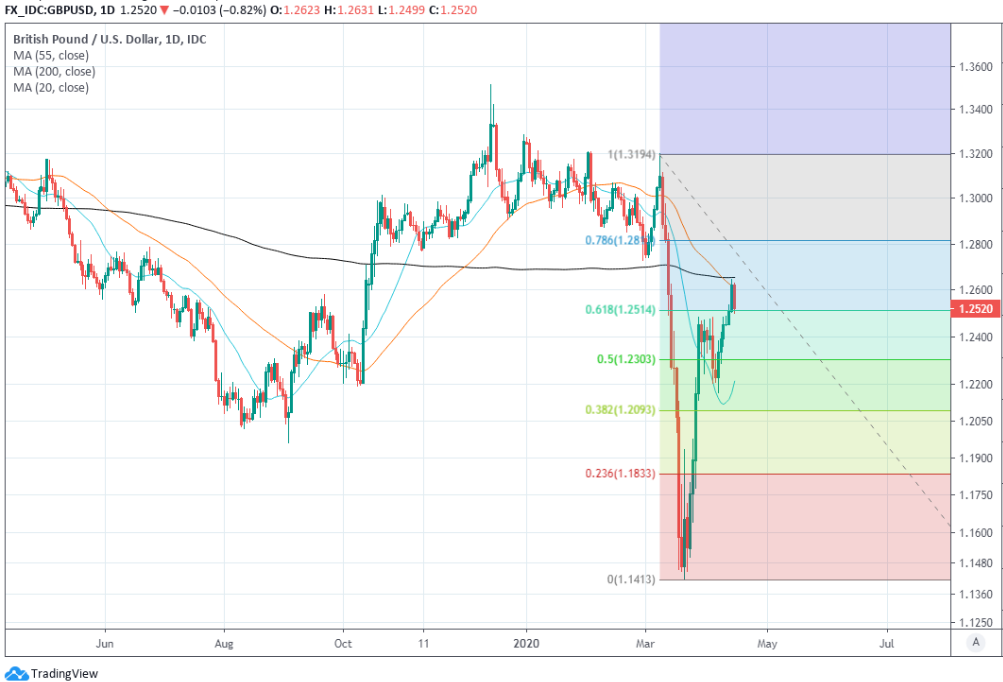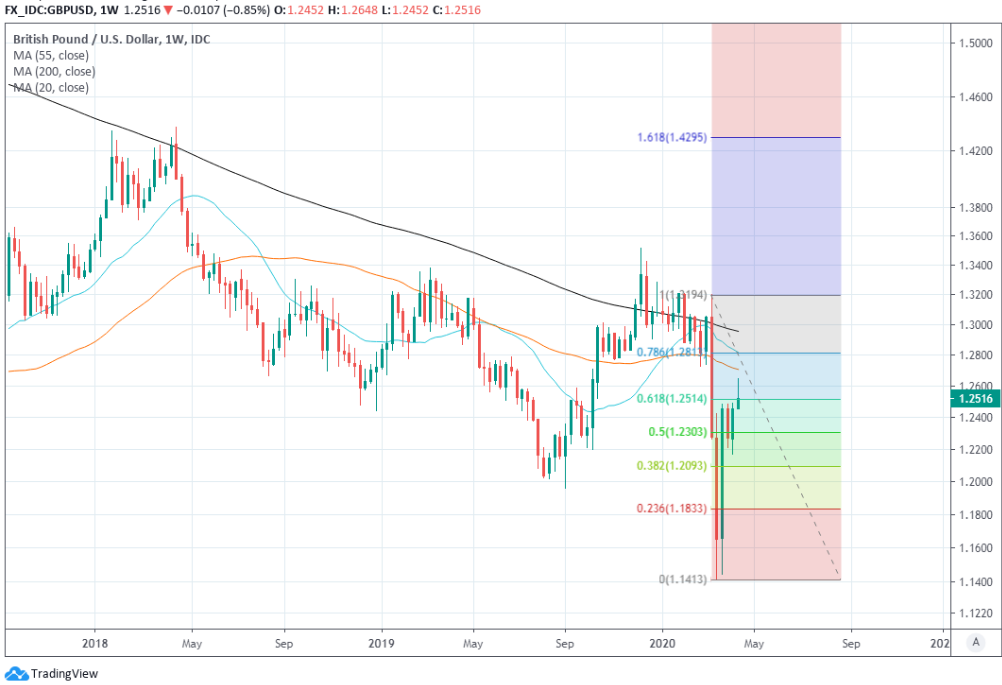The Pound-Dollar Rate: Recovery in Doubt as Risk Assets Falter and 1.2514 Becomes Key Fault Line
- Written by: James Skinner
-

Image © Adobe Images
- GBP/USD spot at time of writing: 1.2491
- Bank transfer rates (indicative): 1.2154-1.2241
- FX specialist rates (indicative): 1.2304-1.2379 >> More information
The Pound-Dollar rate's April recovery was in doubt Wednesday as risk assets faltered the world over, prompting Sterling to reverse course at its 200-day moving-average of prices and taking it back below another technical level that could prove key to the outlook for the exchange rate.
Sterling had risen more than 10% off its late March lows against the Dollar in recent weeks but appeared to capitulte at 1.2654 on Wednesday, the 200-day moving-average of prices. Technical analysts have said the Pound needs to overcome this to put its March collapse behind it, although the average blocked Sterling's path Wednesday and the resulting retreat took the Pound-Dollar rate back below the 61.8% Fibonacci retracement of the 2020 downtrend.
The 61.8% retracement and 1.2514 previously offered firm resistance to the Pound-Dollar rate recovery, blocking its path higher on eight occasions since late March before finally being overcome on Tuesday.
"We are alert to the possibility of failure here. Failure here would cast attention to the 20 day ma at 1.2220. A close above the 200 day ma at 1.2652 is required to target the 78.6% retracement at 1.2817. This is considered to be the last defense for the 1.3201/10 highs," says Karen Jones, head of technical analysis for currencies, commodities and bonds at Commerzbank. "Failure at the 20 day ma is needed to re-target the 1.2163 7th April low and 1.1958 September 2019 low. Failure here will alleviate upside pressure and refocus attention on 1.1491."
Above: GBP/USD at daily intervals with Fibonacci retracements of 2020 trend marked out. 200-day moving-average in black.
Wednesday's price action came amid broad strength in the greenback as well as fresh losses for stock markets and commodities the world over, with little by way of obvious catalysts for an end or pause in a risk rally that many say has been driven mostly by 'short-covering'. The greenback had weakened markedly on Tuesday while the Pound rose sharply alongside other risk assets.
The International Monetary Fund (IMF) forecast overnight a -3% decline in global GDP for 2020 adue to the coronaviru, the weakest performance since 1929, while President Donald Trump said he's suspending funding for the World Health Organization (WHO) in protest over its handling of the initial outbreak in China and its related communications with everybody else. China's Foreign Ministry says the U.S. "should fullfil its obligations" to the WHO while the United Nations secretary said "now is not the time to reduce resources."
Forecasts of a global recession would hardly support risk assets and the prospect of a spat over funding of the WHO might be seen as risking a distraction of policymakers from the containment of the coronavirus, but markets knew of the global predicament before the IMF opined on it while relations between the White House and Beijing were already frosty.
"The US's decision to withhold WHO funding and support for other IMF member states may also be giving investors a taste of things to come, with the global economy and its institutions likely to undergo structural changes," says Stephen Gallo, European head of FX strategy at BMO Capital Markets. "GBP will remain the FX market's "Brexit currency", which will leave it vulnerable to underperforming its peers during periods of market "risk-off". Our assumption is that the risks of WTO exit from the Brexit transition are rising, so we expect the 1.2650/1.2700 range in the pair to offer good selling opportunities."
Above: GBP/USD at weekly intervals with Fibonacci retracements of 2020 trend marked out.
"The “don’t fight the Fed” narrative drove the USD weaker over the last few weeks, but judging by today’s price action and the technical situation in many USD pairs, we have just seen quite the pivot in market action which has provided a hook for USD bulls," says John Hardy, head of FX strategy at Saxo Bank. "Unable to maintain a rally stance as risk appetite softens – a key signal and [we] note that GBPUSD pivoted right at the 200-day moving average."
The Pound-Dollar rate outlook is hinged largely on demand for the greenback, which is sensitive to investor risk appetite, with broad moves in the U.S. currency having been the main driver of most exchange rate swings over recent weeks. The market is divided over the outlook for the Dollar and risk assets, which is closely connected to the lifting of 'lockdown' coronavirus containment measures, although if Sterling remains below 1.2514 at the Friday close then this will have been the fourth week in which it's attemped and failed to recover above the 61.8% Fibonacci retracement of the 2020 downtrend.
Commerzbank's Jones has been tipping a failure of the recovery around current levels and a subsequent return to and then beneath the March 2020 lows for weeks now, but advocated Wednesday that clients bet against the Pound-Dollar rate with a stop-loss set at 1.2655. She's targeting a fall to the 1.0463 over the next three weeks or so, where Sterling is tipped to remain for months after.
"Failure at the 20 day ma is needed to re-target the 1.2163 7 th April low and 1.1958 September 2019 low. Failure here will alleviate upside pressure and refocus attention on 1.1491, the 2016 low," Jones says.






